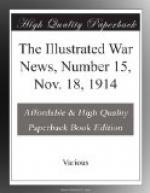Some idea of the destruction wrought by German shells in Nieuport may be gathered from this photograph of the interior of the church, another example of the fact, pointed out under a drawing on another page, that the German gunners do not respect the House of God. The church at Nieuport, which dated from the fifteenth century, was restored in 1903, and its massive baroque tower, visible from afar, could be easily avoided by artillerymen capable of accurate aim and desirous of sparing a sacred building. Nieuport has at least twice before in history been the scene of conflict. In 1489 it made a stubborn resistance to an attack by the French, and near it, in July 1660, was fought the Battle of the Dunes between the Dutch and the Spaniards.—[Photo. by Newspaper Illustrations.]
_______________________________________________________
___________________ 14—The illustrated war news, Nov. 18, 1914.
[Illustration: Bursting shrapnel marking the German “DOVE’S” Track: Shelling A Taube.]
The bursting shrapnel marking the line of flight of that dread “steel dove,” the Taube, comes from a new kind of anti-aircraft gun at the front. This weapon, generally used to fire a stream of shrapnel, also fires shells containing a composition for setting aircraft on fire, and its range-finder marks both the height of an aeroplane and its speed.—[Drawn by A. Forestier from a Sketch by H.C. Seppings Wright.]
[Illustration: Biplane fights biplane: The fate of A vanquished German “Aviatik.”]
We see here the finale of a fierce air-fight near Rheims. A German “Aviatik” biplane passed overhead and a French biplane with a machine-gun went at it, There was a hot contest until suddenly a French shot struck the “Aviatik’s” motor. Taking fire instantly, the German craft fell blazing to the ground, where it burned to a cinder with its airmen.—[Drawn by Georges Scott from an Eye Witness’s Sketch.]
_______________________________________________________
___________________ The illustrated war news, Nov. 18, 1914—15
[Illustration: “Missing and wounded,” At bruges: Stricken Belgians in charge of German red Cross men.]
The German base hospital for the troops in the coast battles and at Ypres was stationed at Bruges when our photograph was taken. The illustration shows two wounded Belgians—one who has just been lifted out from an ambulance-wagon is on a stretcher; the other stands, a grimly picturesque, overcoated and “hooded” figure, in the centre. Among the group of soldiers are sailor-garbed




